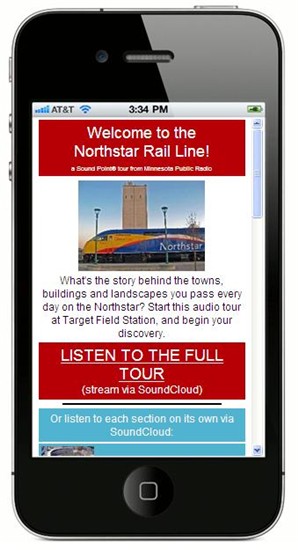
From Ford Motor Co.’s downtown Minneapolis factory to the Oliver H. Kelly Farm in Elk River, a trip on the Northstar Commuter Rail Line is rich in history.
And now there’s more of it.
Minnesota Public Radio’s audio tour of the 40-mile commuter rail line, part of its Sound Point® series, was recently expanded to provide customers additional history about the sights along the corridor (which we learn began as a route for ox carts delivering furs from northern Minnesota and Canada.
The 25-minute tour is accessible by smart phone, allowing transit customers to listen and look as they travel the line. Passengers with WiFi-enabled devices can also access the tour using Northstar's new WiFi service later this year.
In Ramsey, where Northstar’s newest station opened in 2012, the tour tells the story of one of Minnesota’s first paved highways, Highway 10. The road was built in the 1920s to serve wealthy city residents who wanted to drive to their lake homes.
> Listen to the Northstar Commuter Rail Line audio tour
The tour also touches on the 1986 tornado that hit the Springbrook Nature Center in Fridley, which circled for 16 minutes and is considered one of the most-photographed tornadoes in history. Other anecdotes include the story behind the Rum River’s name, a mix of spiritual and spirit-driven inspiration, and the construction of the United States’ first rural nuclear power plant, in Elk River.
Jeff Jones, Engagement Editor for MPR's Public Insight Network, created the audio tour. Jones said he hopes the history will give customers who regularly ride Northstar a greater appreciation for the corridor, which he said “exemplifies the story of Minnesota’s development.”
“I want someone riding it (Northstar) to understand what connects Minnesotans together,” Jones said. “Whether you live in the city or live out in the exurbs of Big Lake, there’s so much that we depend on each other for. But more simply than that, I want people to know what they’re looking at every day, to be able to look at a factory and say, ‘I know what’s going on in there.’”
Jones hopes to continue building the series, adding additional audio and information Big Lake, at the north end of the line. Anyone who would like to share information is invited to contact Jones at jjones@mpr.org.